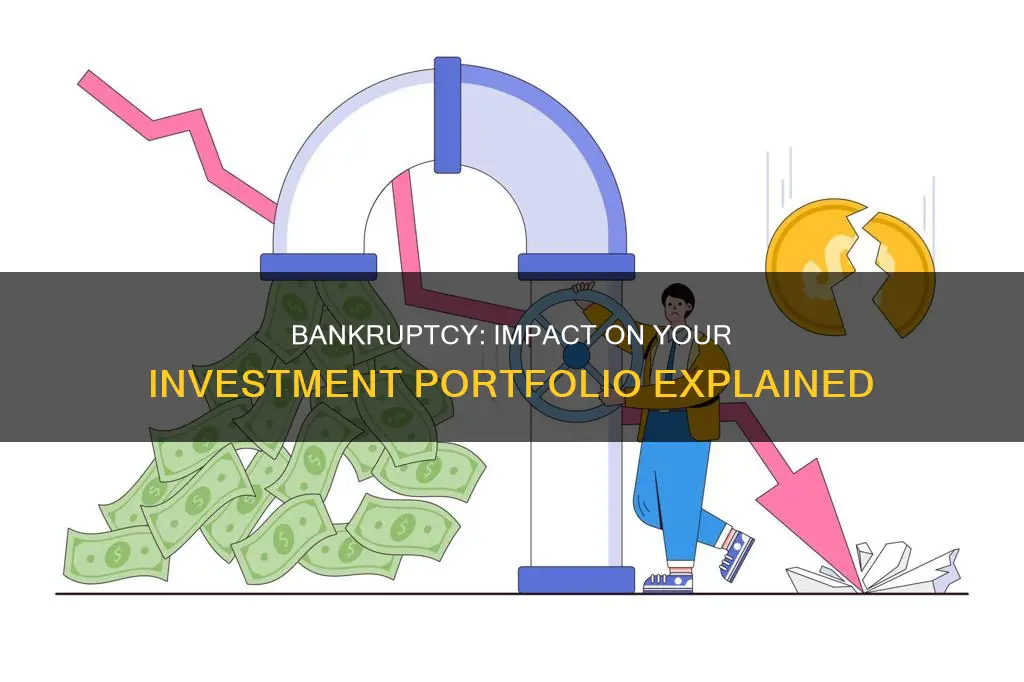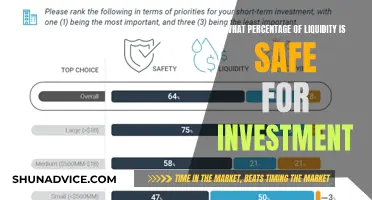
If you're filing for bankruptcy, you're likely already deep in debt and seeing no way to pay your bills. When you file for bankruptcy, you are seeking to eliminate or reduce the debts you owe to your creditors. There are two types of personal bankruptcy under U.S. law: Chapter 7 and Chapter 13. Chapter 7 bankruptcy will sell off many of your assets to pay your creditors, whereas Chapter 13 bankruptcy allows you to retain your assets but requires you to repay your debts over a specified period. In many cases, assets held in retirement accounts, such as a 401(k) or Roth IRA plan, are protected and cannot be touched by creditors. However, bankruptcy will have severe consequences for your credit score and should be considered a last resort.
| Characteristics | Values |
|---|---|
| Types of personal bankruptcy | Chapter 7, Chapter 13 |
| Chapter 7 bankruptcy | Wipes out debts but requires proof of insufficient income to pay off liabilities; creditors may seize assets to pay down debts |
| Chapter 13 bankruptcy | Facilitated by a judge, this involves a reasonable repayment plan with creditors to gradually reduce and eliminate debts; assets are untouched if the repayment schedule is followed |
| Exempt assets | Part of the equity in your home and automobile, tools needed for employment, and other public benefits |
| Non-exempt assets | Property other than the primary residence, recreational vehicles, a second car or truck, collectibles or other valuable items |
| Retirement accounts | In many cases, assets in retirement accounts cannot be touched |
| State variations | Bankruptcy rules vary from state to state |
What You'll Learn
- Retirement accounts are often protected from creditors
- Chapter 7 bankruptcy wipes out debts but requires liquidation of assets
- Chapter 13 bankruptcy restructures debts with a repayment plan
- Common stock shares are last in line for liquidation payouts
- Bankruptcy can stay on your credit report for up to 10 years

Retirement accounts are often protected from creditors
However, it is important to note that there are some exceptions to this protection. For example, while your credit card company cannot access your 401(k) funds to cover overdue balances, the Internal Revenue Service (IRS) can levy funds from your retirement accounts to pay back taxes, although this is usually a last resort. Additionally, if you are taking withdrawals from your retirement accounts as income, these funds may lose their protection and become vulnerable during bankruptcy proceedings.
Furthermore, the specific rules regarding bankruptcy and the protection of retirement accounts can vary from state to state, and it is always recommended to consult a lawyer to fully understand how bankruptcy may impact your investments.
It is also worth noting that bankruptcy can have severe consequences for your credit score and should be considered a last resort. Bankruptcy will remain on your credit report for up to seven years in the case of Chapter 13 or up to ten years in the case of Chapter 7, making it more difficult to obtain credit in the future.
Life Cycle Theory: Savings and Investment Strategies Explored
You may want to see also

Chapter 7 bankruptcy wipes out debts but requires liquidation of assets
Chapter 7 bankruptcy is a legal process for companies or individuals who are unable to pay their debts. It is often a negative situation for those going through it, but it can present opportunities for investors.
Chapter 7 bankruptcy involves the liquidation of a debtor's nonexempt property and the distribution of the proceeds to creditors. This means that the debtor's non-exempt assets will be sold, and the money will be used to repay creditors. The bankruptcy trustee will gather and sell these assets, using the proceeds to pay off creditors in accordance with the provisions of the Bankruptcy Code.
The process begins with the debtor filing a petition with the bankruptcy court in the area where they live or where the business is based. Along with the petition, the debtor must also file schedules of assets and liabilities, a schedule of current income and expenditures, a statement of financial affairs, and a schedule of executory contracts and unexpired leases.
The bankruptcy trustee will hold a meeting of creditors, during which the debtor will be put under oath and asked questions about their financial affairs and property. The debtor must attend this meeting and answer the questions.
While Chapter 7 bankruptcy can provide a "fresh start" by discharging certain debts, it also requires the liquidation of assets. This means that the debtor may lose property, including investments, depending on what is considered nonexempt.
It's important to note that certain types of property are typically protected in a Chapter 7 bankruptcy, such as an individual's car, personal property, and retirement accounts like 401(k) plans. Traditional and Roth IRAs also have some safeguards, with an exemption cap of just under $1.3 million across all IRA assets. However, if you are taking withdrawals from these accounts, they may lose their protection and become vulnerable during bankruptcy proceedings.
In summary, while Chapter 7 bankruptcy can wipe out debts, it requires the liquidation of nonexempt assets, which could include investments depending on the specific circumstances. It is always advisable to consult with an attorney to understand the potential impact on your investment portfolio before filing for bankruptcy.
Ally Invest: Portfolio Margin Trading Options Explored
You may want to see also

Chapter 13 bankruptcy restructures debts with a repayment plan
Chapter 13 bankruptcy, also known as a "wage earner's plan", allows individuals with regular income to restructure their debts and pay them off over a period of three to five years under court supervision. This option is available to individuals and married couples, even if self-employed or operating an unincorporated business, as long as their total debt is under a certain limit (currently $2.75 million in unsecured and secured debt combined).
To apply for Chapter 13 bankruptcy, debtors must compile a list of all their creditors, the amount of money they owe to each, a list of any property they own, information about their income and its sources, and details about their monthly expenses. With the help of a court-appointed bankruptcy trustee, they then submit a plan for repaying their creditors within a period of three to five years. The repayment plan must provide a substantial payback to creditors, at least equal to what they would receive under other forms of bankruptcy, and can use 100% of the debtor's disposable income for repayment.
During the repayment period, the debtor pays an agreed-upon sum of money each month to the trustee, who then distributes the money to the debtor's creditors. Debtors have no direct contact with their creditors under Chapter 13 protection. At the end of the repayment period, any remaining debts, with certain exceptions, will be discharged by the court, meaning that the debtor is under no obligation to pay them.
Chapter 13 offers several advantages over liquidation under Chapter 7. It gives individuals the opportunity to save their homes from foreclosure, as well as reschedule secured debts (other than a mortgage for their primary residence) and extend them over the life of the Chapter 13 plan, potentially lowering the payments. It also has a special provision that protects third parties who are liable with the debtor on "consumer debts", which may include co-signers. Additionally, Chapter 13 acts like a consolidation loan, allowing individuals to make payments to a trustee who distributes them to creditors, thus avoiding direct contact with creditors.
Building a Robust Investment Portfolio: Strategies for Success
You may want to see also

Common stock shares are last in line for liquidation payouts
When a company files for bankruptcy, its stockholders may be entitled to a portion of the assets, depending on the type of shares they hold. However, common stock shares are the last in line for liquidation payouts.
In the case of a Chapter 7 bankruptcy, the company is liquidated, and its assets are sold to pay off creditors. Secured creditors are first in line, followed by unsecured creditors, and then stockholders. Often, common stockholders receive nothing in this scenario.
Chapter 11 bankruptcy, on the other hand, allows a company to reorganize its debt and continue operations. In this case, new shares may be issued to stockholders, and they may not lose much, or any, money.
It's important to note that bankruptcy laws can vary from state to state, and there may be exemptions that protect certain assets. Additionally, retirement accounts, such as 401(k) plans and IRAs, often have safeguards in place and cannot be touched by creditors during bankruptcy proceedings.
If you own common stock in a company that you believe may be heading towards bankruptcy, it is generally advisable to sell your shares beforehand, as their value will likely decrease significantly once a bankruptcy filing becomes official.
Building a Balanced Investment Portfolio: Strategies for Success
You may want to see also

Bankruptcy can stay on your credit report for up to 10 years
When you file for bankruptcy, it can have a huge impact on your credit. A bankruptcy filing will always be considered a "very negative event" by your credit score. Not only will it cause your score to drop by at least 200 points, but it will also stay on your credit report for up to 10 years, depending on the type of bankruptcy. During this time, your ability to qualify for new credit accounts, rent an apartment, open new utility accounts, find a job, or qualify for lower insurance premiums may be affected.
Chapter 7 bankruptcy, also known as liquidation bankruptcy, is the most common form of consumer bankruptcy. It involves selling property to pay back creditors and can stay on your credit report for up to 10 years from the filing date.
Chapter 13 bankruptcy, on the other hand, is a reorganization bankruptcy that allows debtors to restructure their debts under court supervision. This type of bankruptcy generally remains on credit reports for seven years from the filing date.
While the impact of a bankruptcy filing on your credit score will lessen with each year, it is important to note that late payments and discharged accounts can continue to affect your score while they are part of your credit report. Additionally, even when the bankruptcy is discharged, it will not be removed from your credit report and could still affect your score.
To rebuild your credit after bankruptcy, you can monitor your credit reports for accuracy, check your credit scores for changes, practice good credit habits, and consider applying for a secured credit card or a credit-builder loan.
Investment and Savings: Synonymous Expressions for Financial Equality
You may want to see also
Frequently asked questions
It depends on the type of bankruptcy you file for. Under Chapter 7 bankruptcy, your non-exempt assets will be sold to pay off your creditors. Under Chapter 13 bankruptcy, you get to keep your assets but must follow a repayment plan to gradually reduce and eliminate your debts.
Yes, in many cases, assets held in retirement accounts such as 401(k) or Roth IRA plans are protected and cannot be touched by creditors.
Chapter 7 bankruptcy is generally chosen by individuals with lower incomes and few assets. To be eligible, you must prove that you don't generate enough income to pay off existing liabilities. Chapter 13 bankruptcy, on the other hand, allows you to keep your assets but requires you to stick to a repayment plan.







